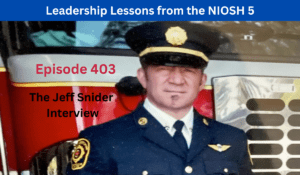In this interview, Dr. Gasaway talks with Jeff Snider about the NIOSH 5 – or the five most often cited contributing factors in Line of Duty death investigations and lessons for leader
Jeff Snider has served with the Canadian military as a Special Forces Operator (3 CDO), a Correctional Officer at a maximum-security facility, and 28 years in the Fire Service, serving in the positions of Firefighter, Lieutenant, Captain, K9 Handler, Acting Training Officer and Assistant Chief, in both the Vancouver Fire and Rescue Services, and the Abbotsford Fire Rescue Service.
Jeff has been involved as an instructor in the Fire Service since 1997. Outside of the departments that he has worked for as a firefighter, he has been fortunate enough to have travelled all over BC, across Canada, and as far south as Mexico and Peru, in his role as an instructor/evaluator.
Jeff’s role now, as the Chief Instructor for the Practical N Tactical Training Group, allows him to work with like-minded, dedicated instructors, who understand that teaching is an outstanding opportunity to “pour back into” the community that has provided so much to them. He sees this as both a privilege and a pleasure.
When Jeff’s not at work, he is spending time with his “Much Better Half”, his “mutts”, his family and friends. Exercising brain and body is a priority so he will often be lifting something, rolling with his Jiujitsu buddies or reading something. Otherwise, you may find him hiking the woods, building unusual playhouses for his grandchildren or carving things with a chainsaw!
The NIOSH five are:
- Improper Risk Assessment
- Lack of Incident Command
- Lack of Accountability
- Inadequate Communications
- Lack of SOPs or Failure to Follow Established SOPs
These are the top 5 causal factors that contribute to the ultimate outcomes in the investigated LODD reports. And while we are on the topic, please tell me you are reviewing, personally and with your crew, each and every NIOSH Line of Duty Death report. This is an invaluable resource, made available to all of us. When tragedy strikes our Fire Service family, it is imperative that we don’t lose the lessons that others have paid the highest price.
These five leading causes can also be attributed to the most common leadership failures, in the Fire Service, and many other organizations as well.
Here is an outline of what we’ll be talking about today:
1 – Inadequate communications
- Listen (verbal and non-verbal).
- How you communicate your message.
- Clear and concise message.
- Public speaking skills.
- No unnecessary messaging.
- Honest feedback.
2 – Improper risk assessment
- 360 problems before you start making decisions.
- Understand the problem before solutions.
- Spend time with personnel.
- Understand personnel and their life challenges.
- Situational awareness.
- Reading people.
- Self awareness: My values personal life, feelings, reactions.
- Character: Acting with integrity in line with your values.
- You can’t fire a canon from a row boat.
3 – Lack of incident command
- Someone has to be in charge.
- Take your time when making decisions.
- Set your ego aside.
- Use the knowledge of others as a resource.
4 – Lack of accountability.
- Character, integrity, commitment, accountable.
- In line with your values.
- Be accountable to your personnel.
- Keep best interest of personnel in mind.
- Lead up the chain of command.
- Accountable to the chief.
- Accountable to the city’s elected and appointed officials.
- Keep the complaints internal.
- Focus your energy for good.
- Accountable to the community.
5 – Lack of, or failure to, follow standard operating procedures (SOPs).
- Train on SOPs.
- Officer need to know SOPs.
- Make sure SOPs are up to date.
- Be proactive to know and ensure SOPs are up-to-date.
Jeff Snider Contact Information
PracticalNTactical.net
About the Host
Richard B. Gasaway, PhD, CSP is widely considered a trusted authority on human factors, situational awareness and the high-risk decision making processes used in high-stress, high consequence work environments. He served 33 years on the front lines as a firefighter, EMT-Paramedic, company officer, training officer, fire chief and emergency incident commander. His doctoral research included the study of cognitive neuroscience to understand how human factors flaw situational awareness and impact high-risk decision making.
Contact us
www.SAMatters.com
www.RichGasaway.com
612-548-4424 (office)
Let’s Get connected
Facebook: SAMatters
LinkedIn: Rich Gasaway
LinkedIn: Situational Awareness Matters
Twitter: Rich Gasaway
Youtube: SAMattersTV
itunes: SAMatters Radio
Stitcher Radio: SAMatters Radio
Google Play: SAMatters Radio
iHeart Radio: SAMatters Radio
Firefighter Near Miss Reporting System
http://www.firefighternearmiss.com/
The SAMatters Show is the longest running, fastest growing, safety focused program on the Internet. If you know a company that might be interested in advertising their product or service to our listeners and viewers, ask them to contact us at SAMatters.com.
Episode length: 62 minutes

